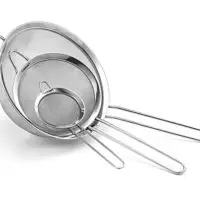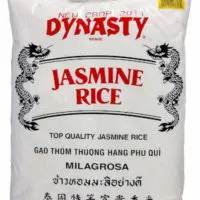Chinese sausage fried rice 臘腸炒飯 is an ideal dish for a quick meal. This dish is also a welcome respite from elaborate cuisine and binge eating during the Chinese New Year.
Therefore, I have made this simple fried rice with some Chinese sausage, and I hope this is the recipe you are looking for after preparing all the complicated Chinese New Year dishes.
In this article, I want to explain how to prepare Chinese sausage fried rice, which only takes 20 minutes.
This Chinese sausage fried rice recipe only required some essential ingredients available in most Chinese kitchen pantries.
Note: This post may contain affiliate links. Please read my privacy policy for more info. I may receive commissions for purchases made through links in this post. As an Amazon Associate, I earn from qualifying purchases.

Since my cooking style has influenced Hong Kong cuisine and Malaysian cooking, you will notice that I coat the rice with raw eggs before turning up the heat to produce Hong Kong styled golden-colored fried rice (黄金炒饭). I also use shallot oil and sprinkle the crispy shallots on top of the fried rice, a Malaysian-influenced method. As you may know, fried shallot is frequently used in soup noodles and rice dishes in Malaysia.
The result is a fried rice dish with colorful elements and a deeply savory flavor from the Chinese sausage, fried shallots, and scallions.
Let me dive into the details and show you how to prepare it step-by-step.
1. Pre-cook the rice
A. Long-grain rice is most suitable for stir-frying
I use local long grain rice for this recipe. Long-grain rice is a staple for the Chinese, which is also my favorite. It is less sticky than short-grain rice (such as Arborio and Japanese rice) and therefore requires less oil to prevent sticking during stir-frying.
Basmati rice is a super long grain, but the cost is higher. I do not use it regularly but have tried it once, which turned out wonderfully.
If you intend to prepare Japanese fried rice (not this recipe), use the short-grain rice and stir-fry over a less intense heat to avoid sticking to the wok.
B. Overnight rice is better than freshly cooked rice for this Chinese sausage fried rice
Most of us prepare fried rice at home by using leftover rice. It is a popular way to use all the leftover food in the refrigerator. Leftover white rice has an obvious advantage over fresh rice for stir-frying because it is dryer and, therefore, less sticky. Sticky rice is messy for stir-frying as it will stick on the wok.
If you are boiling the rice specifically for stir-frying, do the following to mimic the overnight drying process :
- We usually rinse the rice only two to three times or until it is clean. However, if it is only for frying, rinse the rice until the water runs clear to remove as much starch as possible. This way will reduce the sticky problem during stir-frying.
- Cook the rice with slightly less water so that the rice has a firmer texture. Experienced home cooks can make a reasonably accurate estimation. If you are new to cooking rice, the water I use to cook rice for frying is 1.6x the dry weight (before rinsing) of rice. Add this amount of water to the drained and washed rice and cook in the rice cooker (Note: Use 1.75x if you cook it as steamed rice, not for stir-frying.)
C. How to avoid the rice clumping together during frying
The common problem while stir-frying rice is that it will stick together to form lumps. Here are my two tricks to ensure the rice will not clump together during stir-frying.
- Spread the rice on a tray and blow it under the fan for 15 minutes. The rice will become firmer and dryer.
- Wear disposable gloves to break the lumps of rice before stir-frying. The rice is easier to fry by breaking it up first. The rice grains will be mashed if you break the lumps in the wok with the spatula.
2. Deep-fried shallots
This step is optional. You can skip this section and use any cooking oil to stir-fry the rice.
Since living in Malaysia, my Chinese cooking style has been localized to a certain degree. Deep-fried shallots and oil are popular in many local cuisines.
- Deep-fried the shallot until crispy. The crispy shallots add a layer of flavor and double as a garnish
- The shallots oil is flavorful. I will use it along with the sausage oil to fry the rice.
Here are the steps:
- Cut the shallots into slices.
- Heat the oil in a pan over medium heat
- Put the shallots into the hot oil.
- Deep-fried shallots until light brown. Remember that the deep-fried shallots’ color will become darker after removing from the oil.
- Pour the oil and the shallot through a wire mesh strainer. Keep the fried shallots in an airtight container to preserve their crispiness. The remaining oil will be used to stir-fried rice.
3. Cut the sausage and other ingredients
Chinese sausage (lap cheong) had a strong savory flavor due to the curing process. Therefore, the seasoning in this recipe should be light and let the flavor of the Chinese sausage stands out. You can, of course, include other favorite ingredients if you prefer.
a. What other suitable ingredients can be included in the recipe?
The primary purpose of this recipe is to demonstrate the entire cooking process, so I keep it simple.
Add any leftover cured meat 腊肉, Char Siu, or barbecue pork after the Chinese New Year to the rice during stir-frying. You can get it in the Asian market near you. Other ingredients that are suitable for fried rice are shrimp and squids. Some people like adding green peas, carrots, and corn, although certain people deem it non-traditional. In my opinion, it is not a concern as long as it tastes good.
b. Pre-treatment for the sausage before stir-frying
The casing of the Chinese sausage is edible, but it tastes better after removing it. Place the Chinese sausage in boiling water for twenty seconds. The casing will bulge out and detach. Remove it from the pot and let it cools. You can now strip off the casing easily since it no longer shrinks and adheres to the sausage.
You can diagonally cut the Chinese sausage into thin slices or small dice.
c. Stir-fried the Chinese sausage separately
I like to render the oil from the Chinese sausage and use it to fry the rice. The flavor of the sausage will infuse into the rice more effectively this way.
- Add a small amount of oil to the wok.
- Sauteed the Chinese sausage slowly until it turned aromatic and the pork fat rendered.
- Remove the Chinese sausage and keep the oil in a wok.

4. Get ready for other ingredients
Coarsely chop a few cloves of garlic, and cut a few stalks of scallions into short pieces.
Get ready for the seasonings- light soy sauce, ground white pepper, and some salt.
The seasonings I use in this recipe are quite simple. You may want to switch it up by adding some dark soy sauce should you prefer a darker color. Since I want to keep the color of the fried rice bright yellow, I will only use light soy sauce, which is comparatively more umami than dark soy sauce. Oyster sauce is optional, and I do not use it to keep it simple.
You can substitute parts of the light soy sauce with Vietnamese fish sauce.
Another welcome addition is adding some sesame oil right before serving.
5. Cook the Chinese sausage fried rice
Once we have everything ready, the stir-frying process is quite simple.
Here are the steps:
- Heat some shallot oil in the wok.
- Saute the chopped garlic until aromatic.
- Pour the beaten egg into the wok. You can scramble the eggs before adding the rice or coat the rice with the uncooked egg.
- If you scramble the egg first, remove the scrambled eggs, then add the rice to the wok to continue frying.
- If you mix the uncooked egg with the rice, stir-fry it over low heat until the egg is fully cooked and encase each grain of rice inside.
- Seasoned rice with light soy sauce, salt, and ground white pepper.
- Now turn to high heat (to the end) to stir-fried rice to create the wok hei (wok aroma). Add a splash of Shaoxing wine at this point, which is optional.
- Return the scrambled egg to the wok ( if you are using this method) and throw in the chopped scallions.
- Dish out immediately. Garnish with more chopped scallions and fried shallots.
Other usages of Chinese usage
Chinese sausage can be served simply by steaming it and cut into thin slices, prepared creatively for various delicious meals. For example, it can make clay pot rice, cured meat, and mushrooms. However, a much simpler way is to use Chinese sausage as the main ingredient of fried rice. This cooking method is extremely useful after everyone gets bored eating those typical Chinese New Year dishes. It is also a wonderful way to use the leftover sausages and other foods in the refrigerator.
Chinese Ssausage Fried Rice

Chinese sausage fried rice is an ideal dish for a quick meal. This dish is also a welcome respite from the elaborate cuisine and binge eating during the Chinese New Year.
Therefore, I have made this simple fried rice with some Chinese sausage, and hope that this is the recipe you are looking for after preparing all the complicated Chinese New Year dishes.
Ingredients
- 2 tbsp cooking oil (or shallot oil)
- 2 cloves garlic, minced
- 1 Chinese sausage, cut into diagonally
- 2 eggs, lightly beaten
- 250g (9 oz) overnight, leftover steamed rice
- 2 tsps light soy sauce
- 1/2 tsp ground white pepper,
- 1/4 tsp salt
- 2 tbsp chopped scallion
- 2 tsp fried shallot
Instructions
- Break the lumps of cooked rice with your hand.
- Deep-fried the shallot until crispy. Use the shallot oil to fry the rice.
- Place the Chinese sausage in boiling water for twenty seconds. The casing will bulge out and detached. Remove it from the pot and let it cools.
- Cut the Chinese sausage into small dices.
- Stir-fried the Chinese sausage until the oil rendered.
- Remove the Chinese sausage and keep the oil in a wok. Add some shallot oil if it is not enough.
- Saute the chopped garlic until aromatic.
- Pour the beaten egg into the wok. Add the rice.
- Stir-fry it over low heat until the egg is fully cooked and encase each grain of rice.
- Return the sausage to the wok.
- Seasoned rice with light soy sauce, salt, and ground white pepper.
- Now turn to high heat to stir-fried rice until aromatic.
- Add the scallions.
- Dish out immediately. Garnish with more chopped scallions and fry shallots.
Recommended Products
As an Amazon Associate and member of other affiliate programs, I earn from qualifying purchases.
Nutrition Information:
Yield:
1Serving Size:
1Amount Per Serving: Calories: 842Total Fat: 59gSaturated Fat: 12gTrans Fat: 0gUnsaturated Fat: 42gCholesterol: 413mgSodium: 2017mgCarbohydrates: 50gFiber: 2gSugar: 2gProtein: 27g
This data was provided and calculated by Nutritionix on 1/22/2020





Yee CS
Tuesday 3rd of November 2020
After step 6, when do we add back the Chinese sausage into the fried rice?
KP Kwan
Wednesday 4th of November 2020
Hi Yee, Return the sausage to the wok after cooking the rice with egg. I have added step 10 for this in the recipe. Thanks for pointing out the confusion. KP Kwan
Chan
Friday 31st of January 2020
KP Kwan, thanks for sharing and Happy New Year to you.
KP Kwan
Friday 31st of January 2020
Happy new year to you too :)
Loraine Stables
Wednesday 22nd of January 2020
Looks fabulous but the sausage is quite expensive is there an alternative outlet thanks loraine£41 on Amazon
KP Kwan
Saturday 25th of January 2020
Hi Loraine, Chinese sausage has its unique flavor, so there is no real substitute. However, you may use bacon instead of Chinese sausage to make bacon fried rice which is delicious. KP Kwan
KP Kwan
Wednesday 22nd of January 2020
Hi, this is KP Kwan. I am happy to see you in this comment area, as you have read through my recipe. I am pleased to reply to any questions and comments as soon as possible.
Elsa Lock
Wednesday 22nd of January 2020
Delicious! Very clear video with all the details. HAPPY CNY KP KWAN. I will celebrate next with this dish as well. Thanks , Elsa